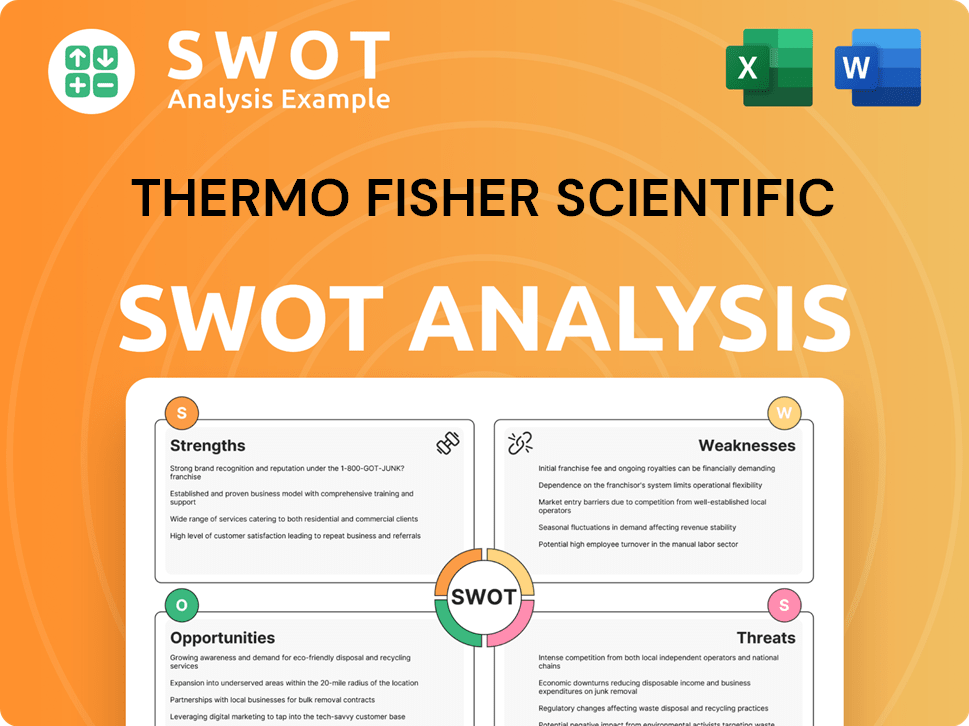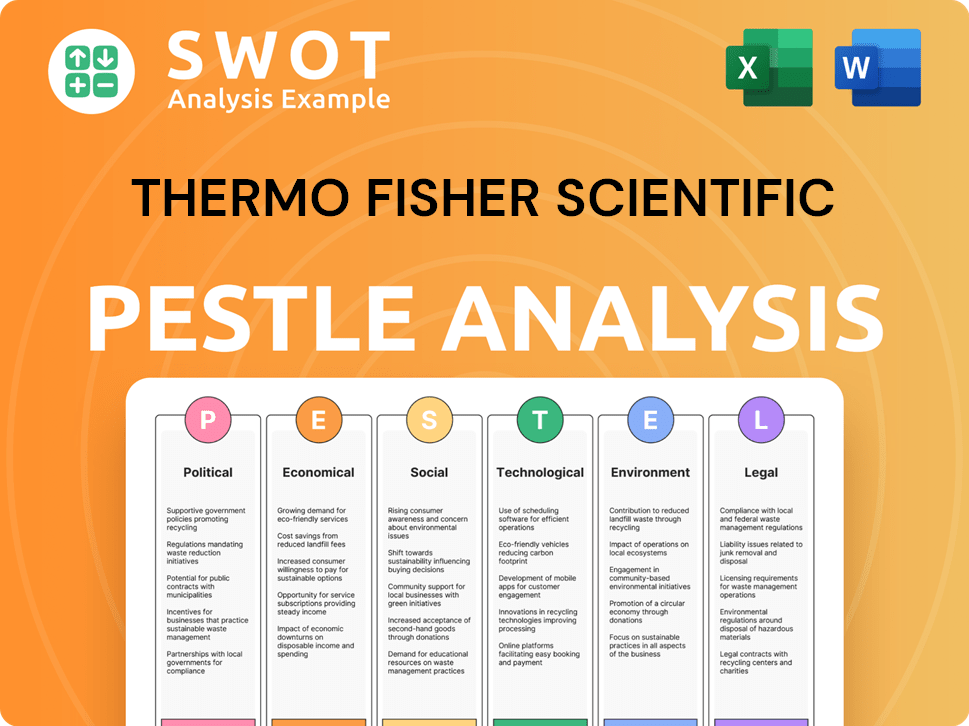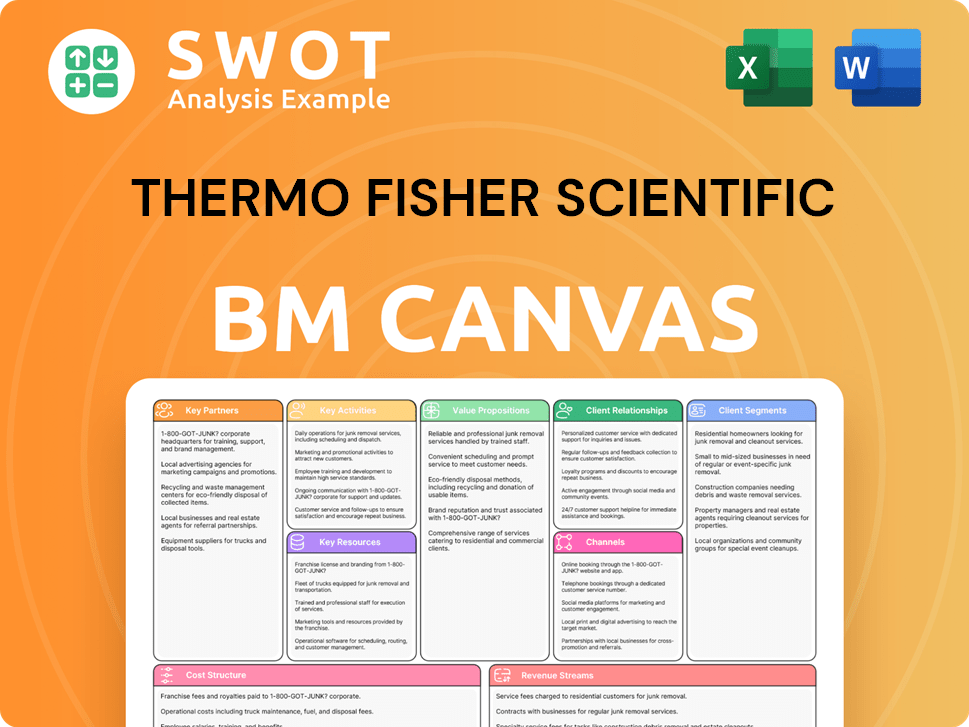Thermo Fisher Scientific Bundle
Can Thermo Fisher Scientific Continue Its Ascent?
From its humble beginnings, Thermo Fisher Scientific has evolved into a scientific services giant, but what fuels its continued success? The 2014 acquisition of Life Technologies was a game-changer, significantly broadening its reach in the scientific community. This Thermo Fisher Scientific SWOT Analysis will help us understand the company's strengths and weaknesses.

This exploration delves into the core of Thermo Fisher Scientific's growth strategy and its ambitious future prospects. We'll dissect the company's strategic initiatives, examine its financial performance, and analyze its position within evolving market trends. Understanding Thermo Fisher Scientific's competitive advantages and expansion plans is crucial for anyone interested in the future of Thermo Fisher Scientific in the healthcare industry.
How Is Thermo Fisher Scientific Expanding Its Reach?
Thermo Fisher Scientific's Growth strategy is heavily focused on expanding its global footprint and diversifying its product offerings. This involves both organic growth through internal innovation and strategic inorganic growth via mergers and acquisitions (M&A). The company aims to capitalize on market trends and strengthen its position in the scientific and healthcare sectors.
A key element of their approach is to tap into high-growth markets, particularly in the Asia-Pacific region. This includes significant investments in China and other emerging economies. These investments are designed to meet the growing demand for advanced scientific solutions and healthcare infrastructure in these areas.
The company continuously launches new products and enhances existing ones. They focus on areas like bioproduction, cell and gene therapy, and clinical diagnostics. This strategy ensures that Thermo Fisher Scientific remains a comprehensive partner for its global scientific customers.
Thermo Fisher Scientific is increasing its presence in the Asia-Pacific region, particularly in China. This expansion is driven by the rising demand for healthcare and life sciences research solutions. The company has invested in expanding its manufacturing and commercial footprint to capitalize on this growth.
The company is actively expanding its product and service offerings, especially in bioproduction, cell and gene therapy, and clinical diagnostics. This diversification helps to meet the evolving needs of its customers. New products are regularly launched to address emerging market demands.
M&A remains a core strategy for Thermo Fisher Scientific to enhance its capabilities and enter new markets. The company continuously evaluates potential acquisitions to strengthen its technology portfolio. This approach helps in gaining market share and expanding service offerings.
Thermo Fisher Scientific is heavily involved in supporting the biopharmaceutical industry. They provide essential tools and services for vaccine and therapeutic development and manufacturing. This focus aligns with the growing demand for advanced healthcare solutions.
Thermo Fisher Scientific's expansion initiatives are designed to drive Future prospects and sustain long-term growth. These efforts include strategic investments in emerging markets and continuous product innovation. The company's focus on M&A activities also plays a crucial role in its expansion strategy.
- Expansion in Asia-Pacific, particularly in China, to capitalize on the growing healthcare and life sciences markets.
- Continuous product development and launches in areas such as bioproduction, cell and gene therapy, and clinical diagnostics.
- Strategic mergers and acquisitions to enhance technology portfolios and expand market share.
- Focus on supporting the biopharmaceutical industry through essential tools and services.
- The company aims to diversify revenue streams and remain a comprehensive partner for its global scientific customers.
For a deeper understanding of the company's financial structure and business model, you can explore the Revenue Streams & Business Model of Thermo Fisher Scientific.
Thermo Fisher Scientific SWOT Analysis
- Complete SWOT Breakdown
- Fully Customizable
- Editable in Excel & Word
- Professional Formatting
- Investor-Ready Format

How Does Thermo Fisher Scientific Invest in Innovation?
The growth strategy of Thermo Fisher Scientific is deeply intertwined with its commitment to innovation and technological advancements. The company continuously invests in research and development to stay at the forefront of scientific discovery and provide solutions to evolving challenges. This focus is critical for maintaining its competitive edge and driving future prospects within the dynamic healthcare and scientific industries.
Thermo Fisher Scientific's approach involves a combination of internal development, strategic collaborations, and acquisitions to enhance its technological capabilities. This strategy allows the company to introduce cutting-edge instruments, consumables, and software solutions that meet the needs of its diverse customer base. By focusing on innovation, the company aims to expand its market share and maintain a strong position in the global scientific market.
The company's dedication to innovation is evident in its substantial R&D spending. For example, in 2023, Thermo Fisher Scientific reported R&D expenses of approximately $1.5 billion. This investment supports the development of advanced analytical instruments, such as mass spectrometers and electron microscopes, which are vital for complex research and diagnostics. This commitment to technological advancement is a cornerstone of its long-term growth strategy.
Thermo Fisher Scientific consistently invests a significant portion of its revenue in research and development. This investment is crucial for developing new products and maintaining a competitive edge. The company's R&D spending in 2023 was approximately $1.5 billion.
The company is actively involved in digital transformation, integrating technologies like AI and automation. This enhances data analysis capabilities and streamlines laboratory workflows. These advancements lead to faster and more accurate research outcomes.
Thermo Fisher Scientific leverages AI and machine learning to improve its instruments and software. Automation is also a key focus, increasing productivity for its clients. These technologies help accelerate scientific research and improve efficiency.
Sustainability is an integral part of Thermo Fisher's innovation strategy. The company is developing more energy-efficient instruments and sustainable manufacturing processes. These efforts align with the growing demand for environmentally friendly solutions.
The company has achieved significant breakthroughs, particularly in areas like next-generation sequencing and cryo-electron microscopy. These advancements demonstrate its leadership in scientific innovation. These innovations contribute to the company's sustained growth objectives.
Thermo Fisher Scientific actively engages in strategic collaborations to enhance its technological capabilities. These partnerships help the company access new technologies and expand its market reach. These collaborations are key to driving future prospects.
The company's focus on innovation and technology is critical for its future prospects. By investing in R&D and embracing digital transformation, Thermo Fisher Scientific aims to maintain its competitive advantage and drive growth in the healthcare and scientific industries. This strategy supports its long-term goals and enhances its ability to meet customer needs.
- Advanced Instruments: Development of cutting-edge instruments, such as mass spectrometers and electron microscopes, to support complex research and diagnostics.
- AI and Automation: Integration of AI and automation to enhance data analysis and streamline laboratory workflows, improving efficiency and research outcomes.
- Sustainability: Efforts to develop energy-efficient instruments and sustainable manufacturing processes, aligning with environmental goals and customer demands.
- Strategic Partnerships: Collaborations to access new technologies and expand market reach, fostering innovation and driving growth.
- Market Leadership: Maintaining a strong position in the global scientific market through continuous innovation and product development.
To understand more about the company's core values, you can read about the Mission, Vision & Core Values of Thermo Fisher Scientific.
Thermo Fisher Scientific PESTLE Analysis
- Covers All 6 PESTLE Categories
- No Research Needed – Save Hours of Work
- Built by Experts, Trusted by Consultants
- Instant Download, Ready to Use
- 100% Editable, Fully Customizable

What Is Thermo Fisher Scientific’s Growth Forecast?
The financial outlook for Thermo Fisher Scientific is robust, supported by consistent revenue growth and strategic investments. For the first quarter of 2024, the company reported revenues of $10.34 billion, demonstrating continued strong performance. This solid financial footing allows for ongoing investment in key areas.
Thermo Fisher Scientific's Growth strategy is underpinned by strategic capital allocation, including R&D, acquisitions, and capacity expansion. The company's financial health is further highlighted by a free cash flow of $6.5 billion reported in 2023. This financial strength supports the company's ability to invest in emerging technologies and expand its global reach.
Analysts generally anticipate continued revenue growth, with some projecting a 3-5% annual increase in revenue over the next few years. This growth is expected to be driven by demand in bioproduction, diagnostics, and pharmaceutical research. This positions the company favorably for the foreseeable future, solidifying its Future prospects.
Thermo Fisher Scientific has demonstrated consistent revenue growth, with revenues of $10.34 billion reported in Q1 2024. This growth trajectory is expected to continue, driven by strategic initiatives and market demand.
The company focuses on R&D, synergistic acquisitions, and capacity expansion. These investments are crucial for sustaining long-term growth and maintaining a competitive edge in the market.
Thermo Fisher's strong financial health is evident through its free cash flow of $6.5 billion in 2023. This financial strength enables the company to fund future growth initiatives and maintain operational flexibility.
Thermo Fisher consistently outperforms many peers due to its broad market reach and essential role in the life sciences ecosystem. This strong market position supports its long-term growth strategy.
The company's financial performance is characterized by strong revenue and strategic capital allocation. This Company analysis reveals a commitment to innovation and market expansion.
- Q1 2024 Revenue: $10.34 billion
- 2023 Free Cash Flow: $6.5 billion
- Projected Revenue Growth: 3-5% annually
- Strategic Focus: R&D, Acquisitions, Capacity Expansion
Thermo Fisher Scientific Business Model Canvas
- Complete 9-Block Business Model Canvas
- Effortlessly Communicate Your Business Strategy
- Investor-Ready BMC Format
- 100% Editable and Customizable
- Clear and Structured Layout

What Risks Could Slow Thermo Fisher Scientific’s Growth?
The future of Thermo Fisher Scientific, like any major player in the healthcare and scientific research sectors, faces several potential risks and obstacles. These challenges range from intense market competition and regulatory changes to supply chain vulnerabilities and the need for continuous innovation. Understanding these risks is crucial for assessing the company's long-term growth strategy and future prospects.
Thermo Fisher Scientific's ability to navigate these challenges will significantly influence its financial performance and market share. The company's success hinges on its capacity to adapt to evolving market dynamics, maintain a competitive edge, and capitalize on emerging opportunities. A thorough company analysis reveals the strategic initiatives required to mitigate these risks and sustain growth.
The competitive landscape presents a significant challenge. The company operates in a market with numerous established and emerging competitors, increasing pressure on pricing and the need for constant innovation. Regulatory changes, particularly in the healthcare and pharmaceutical industries, also pose a risk. Changes to regulations can affect product development, manufacturing, and market access, potentially increasing costs and delaying product launches.
Intense competition within the analytical instruments, life science reagents, and diagnostics segments could lead to pricing pressures. Competitors continually introduce new products and technologies, requiring Thermo Fisher Scientific to invest heavily in R&D. Maintaining a competitive edge demands continuous innovation and strategic product development.
The healthcare and pharmaceutical sectors are heavily regulated, and changes in regulations can significantly impact the company. New or stricter regulations can affect product development, manufacturing processes, and market access. Compliance costs may increase, and product launches could be delayed due to regulatory hurdles.
Disruptions in the supply of critical raw materials or components can impact production and delivery timelines. Events such as the COVID-19 pandemic highlighted the vulnerability of global supply chains. Diversifying the supply base and manufacturing footprint is crucial to mitigate these risks.
Technological advancements from new entrants or scientific breakthroughs can render existing products obsolete. This necessitates continuous investment in R&D and the ability to adapt quickly. The company must stay at the forefront of innovative technologies to maintain its market leadership.
Attracting and retaining top scientific and engineering talent is vital for innovation and growth. Competition for skilled professionals is fierce, and internal resource limitations can hinder innovation efforts. A strong company culture and competitive compensation are essential for success.
Economic downturns can affect the demand for scientific products and services. Reduced budgets in research institutions and pharmaceutical companies can lead to decreased sales. Thermo Fisher Scientific must be prepared to navigate economic fluctuations and manage its financial performance effectively.
Thermo Fisher Scientific addresses these risks through a combination of strategies. Diversification of its product portfolio and customer base helps reduce reliance on any single segment. Robust risk management frameworks, including proactive scenario planning, are also crucial. The company's consistent investment in R&D and strategic acquisitions demonstrates its proactive approach to staying ahead of potential disruptions.
In recent years, Thermo Fisher Scientific has demonstrated strong financial performance. For example, in 2023, the company reported revenues of approximately $42.5 billion. The company's continued investment in R&D, amounting to over $1.5 billion annually, supports its long-term growth strategy. The company's ability to adapt to market trends and maintain its competitive advantages will be key to its future prospects.
For a deeper dive into the company's strategic approach, consider exploring the Marketing Strategy of Thermo Fisher Scientific.
Thermo Fisher Scientific Porter's Five Forces Analysis
- Covers All 5 Competitive Forces in Detail
- Structured for Consultants, Students, and Founders
- 100% Editable in Microsoft Word & Excel
- Instant Digital Download – Use Immediately
- Compatible with Mac & PC – Fully Unlocked

Related Blogs
- What are Mission Vision & Core Values of Thermo Fisher Scientific Company?
- What is Competitive Landscape of Thermo Fisher Scientific Company?
- How Does Thermo Fisher Scientific Company Work?
- What is Sales and Marketing Strategy of Thermo Fisher Scientific Company?
- What is Brief History of Thermo Fisher Scientific Company?
- Who Owns Thermo Fisher Scientific Company?
- What is Customer Demographics and Target Market of Thermo Fisher Scientific Company?
Disclaimer
All information, articles, and product details provided on this website are for general informational and educational purposes only. We do not claim any ownership over, nor do we intend to infringe upon, any trademarks, copyrights, logos, brand names, or other intellectual property mentioned or depicted on this site. Such intellectual property remains the property of its respective owners, and any references here are made solely for identification or informational purposes, without implying any affiliation, endorsement, or partnership.
We make no representations or warranties, express or implied, regarding the accuracy, completeness, or suitability of any content or products presented. Nothing on this website should be construed as legal, tax, investment, financial, medical, or other professional advice. In addition, no part of this site—including articles or product references—constitutes a solicitation, recommendation, endorsement, advertisement, or offer to buy or sell any securities, franchises, or other financial instruments, particularly in jurisdictions where such activity would be unlawful.
All content is of a general nature and may not address the specific circumstances of any individual or entity. It is not a substitute for professional advice or services. Any actions you take based on the information provided here are strictly at your own risk. You accept full responsibility for any decisions or outcomes arising from your use of this website and agree to release us from any liability in connection with your use of, or reliance upon, the content or products found herein.